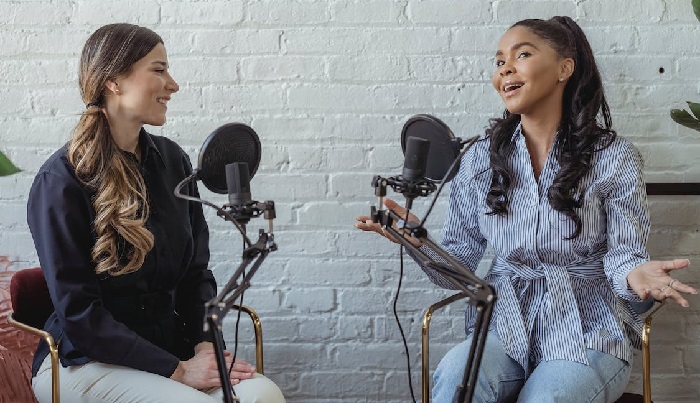10 steps to start your podcast from scratch
Podcasts are easily one of the most consumed types of content online. However, to create one, you will need a good AI tool for podcasting, as well as good planning and knowing the correct steps to start a podcast from scratch. Therefore, our mission with this article is to help make this journey easier.
To create a podcast, you also need a good podcasting microphone and consider purchasing a software to host, distribute, and promote your episodes. Here at AppTuts we have already tested and can recommend:
With the proper use of these tools and good guidance, you can acquire the necessary knowledge to produce a podcast professionally, even if you are just starting out in this universe. In this article, we will talk in detail about the 10 steps to start your podcast from scratch.
What are the types of podcasts?
The most popular podcast formats are interviews and chats. Podcasts that address history, science, entertainment, news, and cinema are also highly sought after by the public. The decision on which model to choose, as well as the length of the episodes on your show, will largely depend on the target audience you want to reach.
For example, if you intend to start a podcast aimed at Generation Z, you could bet on a format that talks about topics of interest to this generation. Regarding the duration, it would be recommended not to exceed one hour to keep the attention of your target audience, who are used to fast content at x2 speed.
This is just one of the tips for you to start your podcast from scratch. Now check out the 10 steps to create your podcast in a professional way and conquer the audience with your content.

Before we start our list with the 10 steps to start your podcast from scratch, take the opportunity to check out our selection of the 10 best podcast cameras in 2023.
1. Think about the foundation of your podcast
First, you need to plan your podcast. Have it clear in your mind why you are betting on this type of content. Although a podcast is an excellent strategy for making money, it is not just about that. After all, even if you don’t have a business to promote, you can dedicate part of your time to spreading knowledge about something you master, for example.
Knowing who your target audience is will help you create a more assertive content format. For example, generation Z does not usually identify with roundtable podcasts, as this type of content tends to be more formal. But if these podcasts aren’t fully appreciated by younger people and that’s what you want to build, work with a focus on Generation X, who highly value well-structured discussions and more traditional approaches.
To reach your target audience, it’s very important to give people a reason why they want to listen to your podcast, showing what value it can add to their lives. A tip for doing this is to think about the theme of about 10 episodes that might interest your target audience. And of course, think of good descriptions for each of these shows. Your podcast description might be the first thing new listeners look at to judge your show, so work on it.
Another component that cannot be missing from your podcast is headphones. That’s why we’ve selected the 12 best headphones for streamers and live streaming in 2023. Oh, and if you have any doubts about which one to choose, check out these 16 tips to choose a good gaming headset!
2. Do research
When doing research for your podcast, the first thing to do is market research. So, take a good look at the major channels of this content format, what topics they address, which ones have a larger audience, which ones have gained more relevance, and the reason for this. Do immersive research work so you can take note of all the other creators’ hot spots and adapt to what might appeal to your target audience.
During this analysis, also try to identify the demand for the subject you intend to address. It’s no use being very good at what you do if no one is interested in the topic of your show. When researching podcasts in your niche, see what audience they have and study ways to attract this type of qualified audience to you.
Another important piece of research you should do is about the topic of your podcast. Before you sit down to record, be clear about what subjects will be featured, so you don’t present an outdated or flawed show that makes you look unprofessional. For this reason, master the topic you are going to address and be original when transmitting the information.
Get to know about the 10 things you need to buy for a cheap live streaming or podcasting setup.
3. Choose your target audience
Niche podcasts often outperform shows that talk about any and all topics. So identify your target audience to develop a niche they can appreciate. After all, if you know exactly who you’re talking to and what that audience expects when they decide to listen to a podcast, you can create content with a more personalized style and tone.
One of the steps to achieve this is to create a persona for your audience. To do this, consider the issues they face to see how your podcast can help them. Also, find out what the passions, hobbies, and personalities of this audience are. By doing this, you will be able to create enjoyable episodes and also know the best way to distribute your content on social media.
But when focusing on your target audience, don’t forget that it’s okay to need to change your content as your podcast evolves. The more you grow, the more different people you reach, and in some cases, you may need to make adjustments to the content. Therefore, always be open to expanding or re-elaborating your audience persona.

4. Choose the topic of your podcast
After you’ve conducted market research and defined your target audience, it’s time to determine the theme of your podcast. As you reach this step, consider the following question: What do you love to talk about, and are people willing to listen? Think of what makes you happy as a starting point and see how to turn that into audio for your target audience. Also, see what topics are trending and understand why people are looking for the most popular topics.
If you already have a good following on social media, use it to help you choose topics for your podcast. A large part of your initial audience should come from your followers, so it’s really important to know what they have to say. Also, talk to influential people in the field or whom you trust. By doing this, you will be able to gain a deeper insight into the topics you want to address.
Finally, just as your audience can change over time, your podcast can and should evolve too. So don’t be afraid to take chances and explore new themes, which may differ a bit from the pacing of the first few episodes. The important thing is to be able to offer what your audience wants and to have a theme that is a big advantage to attract a new audience.
5. Choose the podcast format
To start a podcast from scratch, you need to choose its format. You can explore different ways. Always evaluate the positive and negative sides of each format. For example, the interview podcast is one of the most popular, and it’s no wonder. With it, you can present different perspectives on the same subject. Further, by having guests, you can reach more people as these guests will share their participation in the podcast.
However, when opting for this format, you may encounter some problems, such as unforeseen circumstances with guests who may not be able to attend the recording date and end up disrupting your plans. Also, as there are so many podcasts in this format, it can be difficult for your show to stand out. As such, you can explore other formats or even opt for mixed content, with some interview episodes and others about news, for example.
Still focusing on the format of your podcast, keep the duration of the podcast clear in your mind. You can opt for short 45-minute podcasts or longer episodes that can run for several hours. An average time between 60 and 90 minutes may be ideal.
6. Frequency of release of new episodes
The frequency of releasing new episodes will be according to your routine. Therefore, have a well-defined way to manage the production of your content. You may have in mind the desire to release a podcast episode a week, but if your daily life is very busy, it is likely that you will not be able to achieve this goal. Therefore, consider releasing episodes on a fortnightly basis, for example.
Always remember that constancy is very important to captivate an audience. If your listeners know that every day, every week, every 15 days they will have new content from you, it will be easier for them to keep up with you. However, don’t make the mistake of releasing episodes just to meet deadlines. After all, as important as constancy is the quality of the content you deliver.
By having the idea of a few episodes already planned, you can better organize yourself to create an attractive script that adds value to your audience’s lives. In addition, to further help with your organization, always reserve a moment to dedicate yourself to the production of your podcast, where you disconnect from everything and can think about the content that you will pass on to your viewers.
7. Think about the podcast identity
It’s all about communication, and your podcast’s branding shouldn’t be ignored if you choose to make a video show. So, on your 10-step journey on how to start your podcast from scratch, develop a unique personalization that helps you stand out in a market as large as this one. Express your style well in every aspect of the setting, so people can always easily recognize that the show is yours.
Think about every detail professionally, so that you can be seen as an authority on what you set out to talk about and conquer your audience in the small details. If you have a business, strategically use the decoration of the environment to expose it to your audience. Your brand will remain in the minds of your listeners, which can be an excellent marketing strategy.
Remember to always consider the environment you are recording in when choosing the components of your recording location. If you only have a small space, buying a table that is too large, for example, in addition to not being comfortable at all, can convey the impression of a lack of professionalism. Focus on objects that, even though they bring a minimalist vibe, can be well seen in the eyes of your audience.

8. Invest in equipment and software
To properly follow the 10-step path on how to start your podcast from scratch, you need to invest in quality equipment. For example, microphones, headphones, chairs, and a table cannot be missing from your scenario. Also, off-set, you’ll need a good audio recorder, recording and editing software, good lighting, and cameras. Always seek to invest in cost-effective equipment.
Although all the items mentioned are very important for your podcast, you need to pay more attention to your microphone. In a podcast, your voice and that of your guests, in the case of interview content, must sound perfect. To make your audio even better, you can invest in acoustic treatments that help reduce unwanted echoes and reverberations in the recording environment.
The audio interface is also very important, as it allows you to convert the audio captured by a microphone into a digital signal, making recording and editing easier through audio editing software.
9. Choose the channels where your podcast will be available
It is important to define the channels in which the podcast episodes will be made available. To exemplify, streaming platforms can help in this step, as they are widely used by people who like this content format.
In the case of a video podcast, for example, you can choose to broadcast it on YouTube or on social media such as Instagram and Facebook. Speaking of social media, Twitter is also a good option for live podcast transmissions, if that is the purpose of your content since the Spaces feature is being used more and more by creators.
Another way to stream your podcast is through a website. If you want to raise the level of your work to a more professional level, investing in a website is a good option. In it, you can provide detailed information about your podcast, making it easier to search for previous episodes, in addition to being able to include biographies of you and your guests. A website can also help attract more sponsors than if you just choose to advertise on streaming platforms or social media.
10. Record your podcast
After completing the planning, it’s time to move on to the last step of the 10 steps to start your podcast from scratch: recording your podcast. After setting up the scene, always check your Wi-Fi signal, if the complete recording equipment is ready, and if all the devices that will be used in the recording are charged. If you’re running an in-person interview podcast, make sure your guests are well accommodated.
However, you can also choose to hold podcasts in different places, like a coffee shop, for example. But, when choosing this option, keep in mind that the recording may contain background noise, echo, and other distractions, which can hinder your audience’s understanding of the subject you are addressing. If that’s the case, after recording your podcast, try using software to help you improve the sound quality.
And of course, when recording your podcast, even if it’s the first one, always try to remain calm to convey the message in the way it needs to be presented. This can be difficult for first-time creators, but remember that you’ve done a lot of studying before creating this content, so be confident.
What does it take to produce a podcast?
To start a podcast from scratch, you first need to choose a name, a topic, and the target audience you want to produce for. Afterward, you will need to invest in the acquisition of scenery, software, and equipment, or choose to rent a studio already prepared for this type of content.
How to make a school podcast?
In addition to a good environment to serve as a studio, a set, and the right equipment, one of the most important things in a school podcast is the presenters, who preferably should be teachers or more advanced students, who are intelligent and can communicate more easily.
What are the main types of podcasts?
Podcasts can take a variety of approaches. The most popular format is interview and chat podcasts, however, there are many other topics that are appreciated by the public, such as history, science, entertainment, news, and cinema.
What to say at the beginning of a podcast?
The beginning of a podcast episode should capture the viewer’s attention. Start by introducing yourself, introduce the participants, and give a brief summary of what will be discussed in the episode. Thank viewers and, if you have sponsors, mention them at this time.
What is the best platform for podcasting?
For podcasting from scratch, Buzzsprout is considered one of the best platforms to host and distribute your content. It offers a user-friendly and intuitive interface to help podcasters launch, promote and track their episodes, and easy integration with leading podcast directories like Apple Podcasts, Spotify, and Google Podcasts.
How to make money with the podcast?
You can make money from a podcast with sponsorships and advertising, where companies pay you to promote their products and services. You can also earn from affiliate software, solicit donations, sell merchandise or premium content, host live events, or offer courses related to the topic of the podcast.





